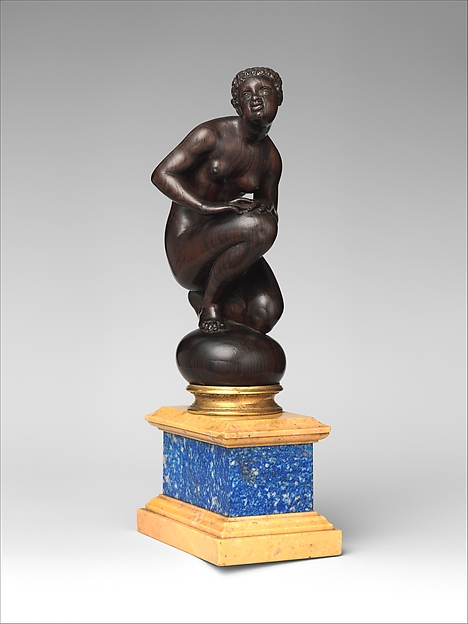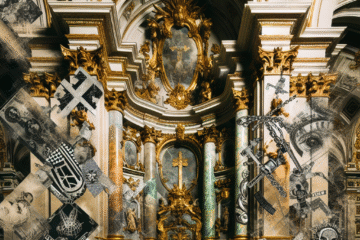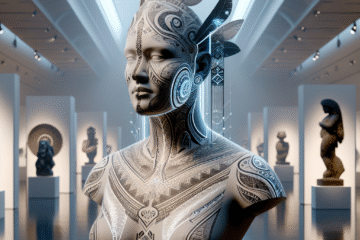
Image title: Kneeling Black woman
Medium: Brazilian rosewood; pedestal: lapis lazuli, marble and gilded metal
Date: early 17th century
Source:
The Met Collection
“
There is nothing happens to any person but what was in his power to go through with.
”
— Marcus Aurelius
Venus Was Black?: Reimagining Classical Sculpture Through African Diasporic Lenses
Introduction: White Marble, Erased Histories
For centuries, the pure white aesthetic of Greco-Roman sculpture has stood as a symbol of classical beauty, often held up as the pinnacle of Western civilization. But what if this whiteness is not merely marble, but a constructed narrative—one that silences the multiplicity of identities that could have existed in antiquity? In recent years, artists from the African diaspora have begun reimagining classical sculpture, not just as a static artistic legacy, but as a site of intervention—a canvas for reclaiming visibility, presence, and historical agency. This article explores how Black contemporary artists reinterpret classical sculpture and how their work challenges colonial art histories, reclaims forgotten narratives, and reshapes our visual culture.
Chapter 1: Classical Ideals and the Construction of Whiteness
The modern popular image of classical sculpture as pristine and white is an illusion. Ancient Greco-Roman statuary was often vibrantly painted, with traces of red, blue, and gold still detectable under ultraviolet light. However, during the Enlightenment, scholars and collectors laundered ancient art into a pale ideal, literally scrubbing traces of color from statues and metaphorically purging them of diversity. This aesthetic aligned with the racial politics of emerging colonial empires, conflating whiteness with civility, purity, and superiority. By neglecting the true polychrome nature of classical art, Europe enshrined a false ideal that shaped centuries of racialized aesthetics.
Chapter 2: The Harlem Renaissance and the Seeds of Artistic Reclamation
During the Harlem Renaissance of the early 20th century, Black intellectuals and artists like Meta Warrick Fuller and Augusta Savage began reshaping Western art narratives to include African and diasporic identities. Savage’s work ‘The Harp’ (1939) fused classical form with African American spiritual motifs, subtly challenging mainstream conceptions of racial heritage and cultural legitimacy. Though not directly reworking classical statuary, these early modern Black artists re-anchored the Western canon in African consciousness, setting the groundwork for future interventions into classically white spaces, both metaphorical and material.
Chapter 3: Postcolonial Critique and the Rise of Counter-Classicism
The post-World War II decolonization movements sparked a reevaluation of cultural symbols and histories, including the classical legacy. Theorists like Frantz Fanon and Edward Said dismantled the ideological underpinnings of colonial aesthetics, creating space for artistic resistance. In the visual arts, this manifested in counter-classicism—a reinterpretation of classical forms through postcolonial and diasporic lenses. Artists such as Fred Wilson began integrating African and classical motifs in museum settings, interrogating the racial dynamics of curation and display. By juxtaposing African artifacts with Greco-Roman styles, they unmasked the colonial hierarchies hidden within museum walls.
Chapter 4: Black Classicism in the 21st Century
Contemporary artists like Kehinde Wiley and Sanford Biggers are leading a powerful wave of Black classicist reimaginings. Wiley’s monumental sculptures, such as ‘Rumors of War’ (2019), use the visual language of equestrian statues—once symbols of imperial white power—to portray contemporary Black subjects in majestic, classical poses. Similarly, Biggers’ ‘Chimera’ series blends African masks with Greco-Roman busts, creating hybrid artifacts that blur the boundaries between timelines, cultures, and identities. These works don’t merely insert Blackness into classical aesthetics; they challenge the exclusivity of those aesthetics and reveal their constructed biases.
Chapter 5: Digital Ruins and Technological Reawakening
Technology offers yet another avenue to reimagine classical art through a diasporic lens. Digital artists like Jacolby Satterwhite employ 3D scanning and augmented reality to reconstruct classical forms as kaleidoscopic, afro-futurist dreamscapes. At the same time, virtual reconstructions of ancient painted statues—using AI and digital pigment analysis—are reviving our understanding of antiquity as intrinsically multicolored and multicultural. Online platforms allow for new forms of artistic expression and transnational collaboration, enabling artists across the diaspora to reclaim history from the marble-white confines of tradition and open new paths for global memory-making.
Conclusion: Toward a Polyphonic Antiquity
The reinterpretation of classical sculpture through African diasporic lenses is not a revisionist fantasy but a necessary excavation. By re-inscribing Black identity onto white marble forms, contemporary artists dismantle the constructed mythology of whiteness that has long dominated our understanding of antiquity. Their artworks are not only acts of reclamation but visionary blueprints for a more inclusive visual history. In the end, the question is not whether Venus was Black, but why we were ever led to believe she couldn’t be.

Image description:
An Opera singer performs at Afro Classical Nights held at Ghana Club in the Greater Accra region of Ghana.
License:
CC BY-SA 4.0
Source:
Wikimedia Commons


